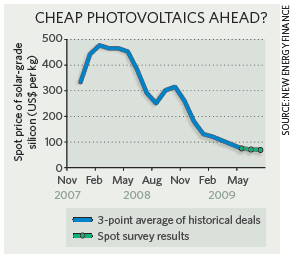
|
|
|
|
|
|
|
News & Views item - August 2009 |
![]() India's Thirty Year, A$23 Billion Plan to Lead in Solar Energy. (August
17, 2009)
India's Thirty Year, A$23 Billion Plan to Lead in Solar Energy. (August
17, 2009)
The prime minister of India, Manmohan Singh, announced on August 3 that India will invest $A23 billion over the next thirty years to transform his nation into a global leader in solar energy. An avowed goal is to reduce the price of electricity generated from solar energy to match that from fossil fuels by 2030.
Currently total solar generated electricity is a mere 5MW but the targets outlined by Prime Minister Singh are 20 GW by 2020, 100 GW by 2030 and 200 GW by 2050.
To understand the scope of the target, total present electric power generation capacity of all India's coal, gas and nuclear plants is 150 GW.
Jayaraman Srinivasan, a climate scientist at the Indian Institute of Science in Bangalore told Nature: "In my view, India should embrace solar purely from the point of energy security, irrespective of global warming. We should have pursued this project from the 1950s with the same vigour we showed for our space and nuclear programmes."
Through 2020 detailed specifications call for solar lighting to be available for 20 million Indian households and 42 million tonnes of CO2 emissions to be saved annually by the switch to solar energy.
As part of the implementation of this solar initiative the government will institute a solar fund, initially A$1.35 billion, to be grown by taxing fossil fuels and the power generated from them at A0.12 cents for every kWh produced.
Additional measures to underpin the plan will include "making it mandatory for existing thermal power plants to generate at least 5% of their capacity from solar power, and for government buildings to install photovoltaic panels on rooftops. Producers connected to the grid will be able to sell their excess solar electricity to utilities; solar-power projects get a 10-year tax holiday; and other 'carrots' for the industry include the duty-free import of raw materials and priority bank loans".
Manu Sharma, of the Centre for Social Markets, a non-governmental organization based in New Delhi, however, believes: "Going from 5 MW to 20 GW in 11 years looks like science fiction," and says India's ten solar-panel manufacturers together have just 80 MW of solar-panel production capacity.
By way of contradiction K. S. Narayanan, who works on polymer solar cells at the Jawaharlal Nehru Centre for Advanced Scientific Research at Bangalore told Nature: "Technology is rapidly changing worldwide and costs will come down once photovoltaic panels are mass produced. We see incremental growth in efficiency of our solar cells in our lab, and globally the scene is changing faster." His view is reinforced by marked reductions in price of silicon for the solar-power industry in the past year as a result of increasing supplies as well as reduced demand. The average price of over US$300 per kilogram in 2008 has dropped to US$67 per kilogram through a combination of new manufacturing facilities coming online while countries such as Spain, for example, are reducing solar subsidies. As a result it is expected that the price of solar panels will halve.
Finally, in Jayaraman Srinivasan's opinion India, as a responsible nation whose economy and population are growing rapidly, should not make the "mistakes" of the developed world. "The solar mission is a win-win proposition as it promises to bring down air pollution, cut down oil bills, and contribute to a greener world."